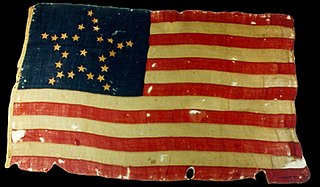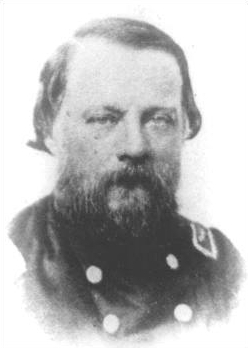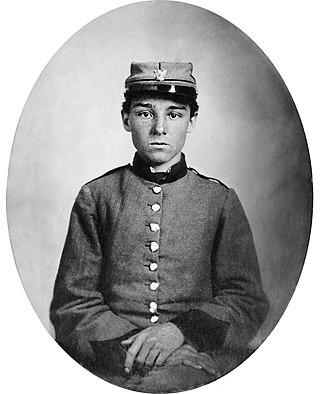
The Texas Brigade was an infantry formation of the Confederate Army that distinguished itself in the American Civil War. Along with the Stonewall Brigade, they were considered the Army of Northern Virginia's shock troops. It fought in every major battle of the Eastern Theater except Chancellorsville.

The 18th Georgia Infantry Regiment was an infantry regiment in the Confederate Army during the American Civil War. Originally brigaded with the three Texas regiments of John Bell Hood's Texas Brigade, it was transferred to Thomas R.R. Cobb's Georgia Brigade after the Battle of Antietam in late 1862. After General Cobb was mortally wounded at the Battle of Fredericksburg, the original colonel of the 18th Georgia, William T. Wofford, became Brigadier General of the Georgia Brigade.

The 2nd Virginia Infantry Regiment was an infantry regiment raised in today's western Virginia and what became West Virginia during the American Civil War for service in the Confederate States Army. It would combine with the 4th, 5th, 27th, and 33rd Virginia infantry regiments and the Rockbridge Artillery Battery and fight as part of what became known as the Stonewall Brigade, mostly with the Army of Northern Virginia.

The 6th Virginia Infantry Regiment was an infantry regiment raised in Virginia for service in the Confederate States Army during the American Civil War. It fought mostly with the Army of Northern Virginia.

The 10th Virginia Infantry Regiment was an infantry regiment raised in Virginia for service in the Confederate States Army during the American Civil War. It fought mostly with the Army of Northern Virginia.

The 17th Virginia Infantry Regiment was an infantry regiment raised in Virginia for service in the Confederate States Army during the American Civil War. It fought mostly with the Army of Northern Virginia.

The 18th Virginia Infantry Regiment was an infantry regiment raised in Virginia for service in the Confederate States Army during the American Civil War. It fought mostly with the Army of Northern Virginia.

The 21st Virginia Infantry Regiment was an infantry regiment raised in Virginia for service in the Confederate States Army during the American Civil War. It fought mostly with the Army of Northern Virginia.

The 24th Virginia Infantry Regiment was an infantry regiment raised in southwestern Virginia for service in the Confederate States Army during the American Civil War. It fought throughout the conflict, mostly with the Army of Northern Virginia. The 24th Virginia's most prominent field officers were Colonels Jubal A. Early and William R. Terry; Lieutenant Colonels Peter Hairston, Jr. and Richard L. Maury; and Majors William W. Bentley, Joseph A. Hambrick, and J.P. Hammet.

The 40th Virginia Infantry Regiment was an infantry regiment raised in Virginia for service in the Confederate States Army during the American Civil War. It fought mostly with the Army of Northern Virginia. Prior to the reorganization of the army after Chancellorsville, it was part of the first brigade of A.P. Hill's Light Division. Field officers were Colonel John M. Brockenbrough; Lieutenant Colonels Fleet W. Cox, Arthur S. Cunningham, and Henry H. Walker; and Majors Edward T. Stakes and William T. Taliaferro.

The 44th Virginia Infantry Regiment was an infantry regiment raised in Virginia for service in the Confederate States Army during the American Civil War. It fought mostly with the Army of Northern Virginia.

The 49th Virginia Infantry Regiment was an infantry regiment raised in Virginia for service in the Confederate States Army during the American Civil War. It fought mostly with the Army of Northern Virginia.

The 10th Virginia Cavalry Regiment was a cavalry regiment raised in Virginia for service in the Confederate States Army during the American Civil War. It fought mostly with the Army of Northern Virginia.

The 9th Louisiana Infantry Regiment or Louisiana Tigers was the common nickname for certain infantry troops from the state of Louisiana in the Confederate States Army during the American Civil War. Originally applied to a specific company, the nickname expanded to a battalion, then to a brigade, and eventually to all Louisiana troops within the Army of Northern Virginia. Although the exact composition of the Louisiana Tigers changed as the war progressed, they developed a reputation as fearless, hard-fighting shock troops.
The 44th North Carolina Infantry Regiment was a unit of the Confederate States Army during the American Civil War.

The 6th Louisiana Infantry Regiment served in the Confederate States Army during the American Civil War. It was part of the Louisiana Tigers. Formed in June 1861 at Camp Moore, it fought in Jackson's Valley campaign, the Battle of Gaines Mill, the Second Battle of Bull Run and its related actions, and the Battle of Antietam in 1862. The next year, it fought at the Second Battle of Fredericksburg, the Battle of Salem Church, the Second Battle of Winchester, and the Battle of Gettysburg before being overrun at the Second Battle of Rappahannock Station. It spent 1864 fighting in Grant's Overland campaign and with Jubal Early in the Valley campaigns of 1864. The regiment fought in the Battle of Hatcher's Run and the Battle of Fort Stedman in early 1865 before surrendering after the Battle of Appomattox Court House in April. It began its service with 916 men and ended with 52.

The 1st Louisiana Infantry Regiment was a unit of volunteers recruited in Louisiana that fought in the Confederate States Army during the American Civil War. Formed in April 1861, the regiment was sent to fight in the Eastern Theater of the American Civil War. Joining a brigade of Louisiana regiments, it fought at Malvern Hill, Second Bull Run, Antietam, and Fredericksburg in 1862, at Chancellorsville, Second Winchester, Gettysburg, and Mine Run in 1863, and at the Wilderness, Spotsylvania, Monocacy, Third Winchester, Fisher's Hill, Cedar Creek, and Petersburg in 1864, and at Appomattox in 1865. At Appomattox, the regiment was only a shadow of its former self.

The 2nd Louisiana Infantry Regiment was a unit of volunteers recruited in Louisiana that fought in the Confederate States Army during the American Civil War. Formed in May 1861, the regiment was sent to fight in the Eastern Theater of the American Civil War. Its first action took place during the Siege of Yorktown. The regiment suffered very heavy losses at Malvern Hill. After joining an all-Louisiana brigade, it fought at Cedar Mountain, Second Bull Run, Antietam, and Fredericksburg in 1862, at Chancellorsville, Second Winchester, Gettysburg, and Mine Run in 1863, and at the Wilderness, Spotsylvania, Cold Harbor, Monocacy, Third Winchester, Fisher's Hill, Cedar Creek, and Petersburg in 1864, and at Appomattox in 1865. The regiment lost over 100 men at both Second Bull Run and Chancellorsville. A company-sized remnant surrendered at Appomattox.

The 8th Louisiana Infantry Regiment was a unit of volunteers recruited in Louisiana that fought in the Confederate States Army during the American Civil War. Formed in June 1861, the regiment was sent to fight in the Eastern Theater of the American Civil War. Joining a brigade of Louisiana regiments, it fought in Jackson's Valley campaign and at Gaines' Mill, Malvern Hill, Second Bull Run, Antietam, and Fredericksburg in 1862. The regiment served at Chancellorsville, Second Winchester, Gettysburg in 1863. At Rappahannock Station in November 1863, most of the regiment was captured. The unit fought at the Wilderness, Spotsylvania, Cold Harbor, and the Valley campaigns of 1864. It served at Petersburg starting in December 1864 and surrendered at Appomattox in April 1865.

The 7th Louisiana Infantry Regiment was a unit of volunteers recruited in Louisiana that fought in the Confederate States Army during the American Civil War. Formed in June 1861, the regiment was sent to fight in the Eastern Theater of the American Civil War. After fighting at First Bull Run, the unit joined the 1st Louisiana Brigade. The regiment served in Jackson's Valley campaign and at Gaines' Mill, Malvern Hill, Cedar Mountain, Second Bull Run, Harpers Ferry, Antietam, and Fredericksburg in 1862. The regiment fought at Chancellorsville, Second Winchester, and Gettysburg in 1863. At Rappahannock Station in November 1863, almost the entire regiment was captured. The remnant of the unit fought at the Wilderness, Spotsylvania, Cold Harbor, and the Valley campaigns of 1864. It served at Petersburg starting in December 1864 and surrendered at Appomattox in April 1865.









